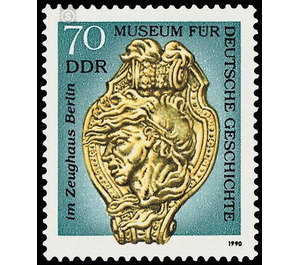Museum of German History in the Zeughaus, Berlin - Germany / German Democratic Republic 1990 - 70 Pfennig
Theme: Architecture
| Country | Germany / German Democratic Republic |
| Issue Date | 1990 |
| Face Value | 70.00 |
| Color | green |
| Perforation | K 14 |
| Printing Type | Rotogravure 2 |
| Stamp Type | Postage stamp |
| Item Type | Stamp |
| Chronological Issue Number | 3061 |
| Chronological Chapter | GER-DDR |
| SID | 592866 |
| In 14 Wishlists | |
Museum of German History - Zeughaus Berlin Museum of German History in the Zeughaus Berlin The Ministry of Posts and Telecommunications of the German Democratic Republic issues two multi-colored special postage stamps. Special cancellation from 6 March to 5 May 1990 Museum of German History in the Zeughaus Berlin The National History Museum of the German Democratic Republic, the "Museum of German History", has for domicile the most imposing secular baroque building of the capital Berlin, the arsenal on the boulevard " Unter den Linden ". The Zeughaus was the only original building from the first urban extension of Berlin to have been preserved from the development that reached Berlin in the second half of the 17th century via the Schleusengraben - a Spreearm -, thus creating the new Friedrichwerder district. As an arsenal for the Berlin fortress it was in addition to its actual purpose as a weapons warehouse from the outset as a repository of trophies, which the Latin inscription above the main portal under the relief portrait of his builder Friedrich III, Elector of Brandenburg (1657-1713), ruled as Elector since 1688; since 1701 as "King of Prussia" Friedrich I.) explicitly stressed. Erected still suggestions of the Elector Friedrich Wilhelm I. (1620-1688, Elector since 1640), the arsenal was mainly in the ten-year period between 1695 and 1705. His architectural character underwent continuous changes in this period; It received its present-day characteristic form from Jean de Bodt (1670-1745), who was the site manager from 1699 to 1707. For a short time, the construction management 1698/99 was also in the hands of one of the most important German Baroque sculptor, Andreas Schlüter (1660-1714); Architectural traces did not leave this interlude. But since 1696 Schlüter has crucially shaped the extraordinarily rich ornamental and sculptural decoration that gives the armory its characteristic features. Schlüter has had a major influence on the overall concept of this side of the building. The large number of sculptures and half-sculptures in the construction directed Schlüter to the assistance of a Steinmetzhütte, in which skillful masters after his models worked. Schlüter's handwriting largely bears the keystones over the window vaults on the ground floor: on the four sides of the outer front are helmets with rich jewelery - in the courtyard, however, there are 22 heads of slain warriors, hung as signs of victory on signs. The great majority of the keystones may have been hewn to the designs Schlüters mostly by Georg Gottfried Weyhenmeier (1666-1715). But some heads show the genuine execution by Schlüter himself. The heads selected for the two postage stamps belong to it. Using heads of slain or dying warriors as architectural detail for building exterior or interior decoration was not uncommon in the time of High Baroque. At the Berlin Arsenal they were designed by the electoral patron apparently as an echo of the benefits of Kurbrandenburgischer contingents in the imperial wars to ward off the Turkish danger in the eighties and nineties of the 17th century. Schlüter, however, made the order of a harmony of humanistic ideas and artistic creative power a plastic confession of disgust for the war. There is no poetic transfiguration of a heroic death delivered, but the unadulterated reflection of pain and suffering. Infused with the artistic means available for a realistic reflection of the expressiveness of human faces, Schlüter created life-like sculptures that are true to life. Thus he not only provided an art historical mark, but also the extraordinary exception of a permanent peace demonstration on a building dedicated to the war. The armory, which served as an arsenal and military museum about two and a half centuries of war, almost fell victim to it during the Second World War, it was badly damaged. His laborious reconstruction in the years 1948 to 1965 was financed by the government of the GDR and included the loving reconstruction of the rich plastic jewelry, u. a. the heads of dying warriors, completely preserved in their original form, which are a magnet for art lovers at the "Schlüterhof" of the Museum of German History.


